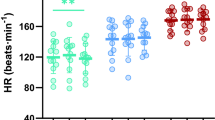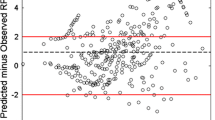Summary
This study examined whether prolonged exercise employing upper or lower body muscle groups led to significant alterations in three differentiated ratings of perceived exertion (RPE). Multiple regression analyses were used to identify those physiological responses which accounted for the greatest variability in these three RPE. Nine volunteer males performed 60 min of arm crank and cycle exercise at similar absolute and at similar relative exercise intensities. There were no significant differences (P>0.05) between arm and leg exercise for oxygen uptake (\(\dot V_{{\text{O}}_{\text{2}} }\)) during the absolute tests (~ 1.60 l·min−1) or during the relative tests (~ 60% peak\(\dot V_{{\text{O}}_{\text{2}} }\)). The RPE included local RPE (muscle and joint exertion), central RPE (ventilatory and circulatory exertion), and overall RPE. During the absolute tests, the final means for all three RPE were lower (P<0.05) for leg than arm exercise. No differences (P>0.05) were found during the relative tests between arm and leg exercise for any of the three RPE. Local RPE was generally higher than central RPE. The various physiological responses accounted for more (total) variance in all three RPE for arm than leg exercise (absolute and relative arm exercise: median R2=0.99; absolute and relative leg exercise: median R2=0.75). Lactate and the ventilatory equivalent of oxygen made the greatest contribution to R2. These data suggest that RPE may be more closely related to relative exercise intensity, and perceptual cues may be more readily monitored from smaller muscle masses such as the upper body. Further, steady-state RPE was not attained during prolonged upper body exercise.
Similar content being viewed by others
References
Allen PD, Pandolf KB (1977) Perceived exertion associated with breathing hypoxic mixtures during submaximal work. Med Sci Sports 9: 122–127
åstrand P-O, Ekblom B, Messin R, Saltin B, Stenberg J (1965) Intra-arterial blood pressure during exercise with different muscle groups. J Appl Physiol 20: 253–256
åstrand P-O, Rodahl K (1970) Textbook of work physiology. McGraw-Hill Inc., New York
Borg GAV (1962) Physical performance and perceived exertion. Gleerup, Sweden
Borg G (1970) Perceived exertion as an indicator of somatic stress. Scand J Rehabil Med 2: 92–98
Edwards RHT, Melcher A, Hesser CM, Wigertz O, Ekelund LG (1972) Physiological correlates of perceived exertion in continuous and intermittent exercise with the same average power output. Eur J Clin Invest 2: 108–114
Ekblom B, Goldbarg AN (1971) The influence of training and other factors on the subjective rating of perceived exertion. Acta Physiol Scand 83: 399–406
Gamerale F (1972) Perceived exertion, heart rate, oxygen uptake and blood lactate in different work operations. Ergonomics 15: 545–554
Gutmann I, Wahlefeld AW (1974) L-(+)-lactate determinations with lactate dehydrogenase and NAD. In: Bergmeyer HU (ed) Methods of enzymatic analyses. Academic Press, New York, pp 1464–1468
Löllgen H, Graham T, Sjogaard G (1980) Muscle metabolites, force, and perceived exertion bicycling at varying pedal rates. Med Sci Sports 12: 345–351
McArdle WD, Katch FJ, Pechar GS (1973) Comparison of continuous and discontinuous treadmill and bicycle tests for max\(\dot V_{{\text{O}}_{\text{2}} }\). Med Sci Sports 5: 156–160
Mihevic PM (1981) Sensory cues for perceived exertion: A review. Med Sci Sports 13: 150–163
Miles DS, Sawka MN, Glaser RM, Petrofsky JS (1983) Plasma volume shifts during progressive arm and leg exercise. J Appl Physiol Respirat Environ Exercise Physiol 54: 491–495
Morgan WP (1973) Psychological factors influencing perceived exertion. Med Sci Sports 5: 97–103
Noble BJ, Metz KF, Pandolf KB, Cafarelli E (1973) Perceptual responses to exercise: A multiple regression study. Med Sci Sports 5: 104–109
Pandolf KB (1978) Influence of local and central factors in dominating rated perceived exertion during physical work. Percept Mot Skills 46: 683–698
Pandolf KB (1982) Differentiated ratings of perceived exertion during physical exercise. Med Sci Sports 14: 397–405
Pandolf KB (1983) Advances in the study and application of perceived exertion. In: Terjung RL (ed) Exercise and sport sciences reviews. Franklin Institute Press, Philadelphia, pp 118–158
Pandolf KB, Burse RL, Goldman RF (1975) Differentiated ratings of perceived exertion during physical conditioning of older individuals using leg-weight loading. Percept Mot Skills 40: 563–574
Pandolf KB, Cafarelli E, Noble BJ, Metz KF (1972) Perceptual responses during prolonged work. Percept Mot Skills 35: 975–985
Robertson RJ (1982) Central signals of perceived exertion during dynamic exercise. Med Sci Sports 14: 390–396
Robertson RJ, Gillespie RL, McCarthy J, Rose KD (1979) Differentiated perceptions of exertion: Part II. Relationship to local and central physiological responses. Percept Mot Skills 49: 691–697
Sargeant AJ, Davies CTM (1973) Perceived exertion during rhythmic exercise involving different muscle masses. J Hum Ergol [Tokyo] 2: 3–11
Sawka MN, Foley ME, Pimental NA, Toner MM, Pandolf KB (1983) Determination of maximal aerobic power during upper body exercise. J Appl Physiol: Respirat Environ Exercise Physiol 54: 113–117
Sawka MN, Miles DS, Petrofsky JS, Wilde SW, Glaser RM (1982) Ventilation and acid-base equilibrium for upper body and lower body exercise. Aviat Space Environ Med 53: 354–359
Skinner JS, Hutsler R, Bregsteinova V, Buskirk ER (1973) Perception of effort during different types of exercise and under different environmental conditions. Med Sci Sports 5: 110–115
Smutok MA, Skrinar GS, Pandolf KB (1980) Exercise intensity: Subjective regulation by perceived exertion. Arch Phys Med Rehabil 61: 569–574
Young AJ, Cymerman A, Pandolf KB (1982) Differentiated ratings of perceived exertion are influenced by high altitude exposure. Med Sci Sports 14: 223–228
Author information
Authors and Affiliations
Rights and permissions
About this article
Cite this article
Pandolf, K.B., Billings, D.S., Drolet, L.L. et al. Differentiated ratings of perceived exertion and various physiological responses during prolonged upper and lower body exercise. Europ. J. Appl. Physiol. 53, 5–11 (1984). https://doi.org/10.1007/BF00964681
Accepted:
Issue Date:
DOI: https://doi.org/10.1007/BF00964681




